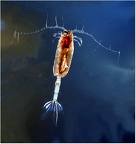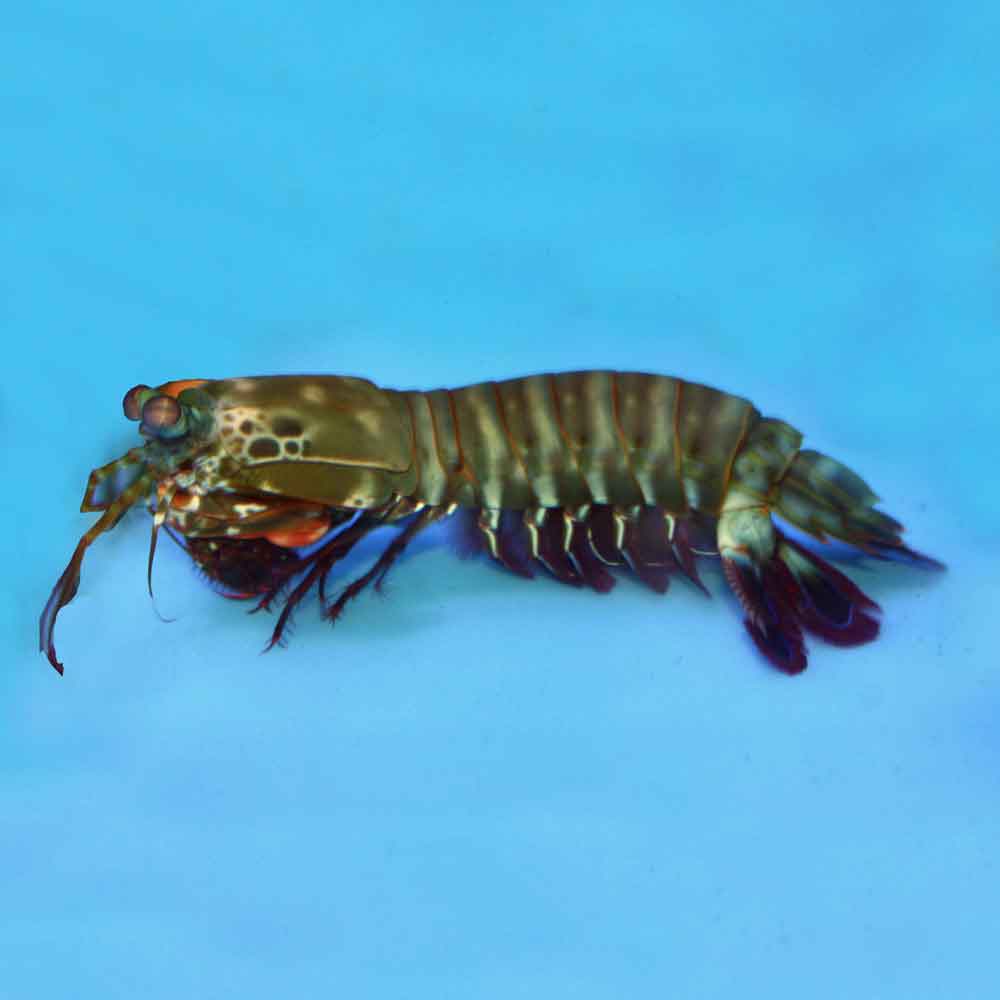Tangs tend to be a favorite among aquarists since they are very colorful and have a taste for algae. Tangs are primarily herbivorous and need a diet rich in algae. There are many algae based food that are great for tangs including live caulerpa, nori strips, and formula 2 that comes in a frozen variety as well as flakes and pellets. Tangs should also be given some meaty food to round out their diet. However, tangs that are fed primarily meaty foods over a long period of time are more likely to suffer from head and lateral line erosion(HLLE). HLLE disease in the short run is not fatal, but over time if the disease continues to progress the fish will stop eating and become lethargic. The open wounds that result will make the fish susceptible to other infections, and these secondary infections may eventually contribute to its demise. The best treatment is prevention; maintain excellent water quality and feed a rich vegetarian diet. Supplementing with a multivitamin (A, D, E, B complex, and Iodine) may also help prevent further erosion. Selcon, garlic guard, and vita-chem are excellent food additives. Tangs are also susceptible to Amyloodinium and Cryptocaryon so proper quarantine is a must. Once tangs make it through the initial quarantine they are usually pretty hardy.
Tangs are generally community fish and get along with most other tank-mates. They don’t usually bother corals and can actually help keep nuisance algae trimmed and under control. Tangs may become territorial and aggressive towards very similar tank-mates or other tangs from the same genus. Tangs are very active swimmers and should not be housed in any tank smaller than 50 gallons but larger is always better.
 In our retail store we have a great selection of colorful tangs. One of the most popular tangs that we sell would be the yellow tang, (Zebrasoma flavesence). Yellow tangs are very hardy but can bully new tank-mates. They will do best if added to a community tank last. Yellow tangs can reach a max size of 8 inches so choose their tank size accordingly. They are very active swimmers and become rather bold. They are sure to be a bright center piece in any tank.
In our retail store we have a great selection of colorful tangs. One of the most popular tangs that we sell would be the yellow tang, (Zebrasoma flavesence). Yellow tangs are very hardy but can bully new tank-mates. They will do best if added to a community tank last. Yellow tangs can reach a max size of 8 inches so choose their tank size accordingly. They are very active swimmers and become rather bold. They are sure to be a bright center piece in any tank.
Another tang closely related to the yellow tang would be the purple tang (Zebrasoma xanthurum). Purple tangs are a gorgeous deep purple to blue with a bright yellow tail. They are  not as readily available as some other tangs but we do have these beauties from time to time. Purple tangs are also pretty feisty once acclimated. They can reach a max size of 10 inches so a large home is a must.
not as readily available as some other tangs but we do have these beauties from time to time. Purple tangs are also pretty feisty once acclimated. They can reach a max size of 10 inches so a large home is a must.
Sailfin tangs, (Zebrasoma veliferum) and (Zebrasoma desjardinii), are one of the larger tangs with adults capable of reaching 16 inches. As juveniles both species of sailfin tangs look identical. As they mature Zebrasoma veliferum tends to retain most of its juvenile coloration where Zebrasome desjardinii will phase out its stripes and change them to spots and their overall coloration becomes muted. Sailfin tangs are rather peaceful tangs and get  along with most other tank-mates, however they do not tolerate others of the same kind or genus unless they are kept in a very large aquarium. They also have great personalities and do recognize the hand that feeds them.
along with most other tank-mates, however they do not tolerate others of the same kind or genus unless they are kept in a very large aquarium. They also have great personalities and do recognize the hand that feeds them.
Another very popular tang is the Hippo tang (Paracanthurus hepatus). They have a bright yellow tail and electric blue body with a black hook shaped mark overlaid on each side. Hippo tangs tend to be shy but may bicker with other tangs in the tank from time to time. Juvenile hippo tangs are usually found in groups but usually do best as a single specimen unless the tank is  very large since adults can reach a max size around 12 inches.
very large since adults can reach a max size around 12 inches.
Another true beauty would be the Powder blue tang (Acanthurus leucosternon). Powder blue tangs have a baby blue body, yellow dorsal fin and caudal peduncle, white anal and ventral fins, and a black face with a white area below the jawline. Powder blue tangs are one of the more delicate tangs so extreme care should be taken when transporting and acclimating this fish. They are also notorious ich magnets so quarantining new specimens is a must. If proper care is given powder blue tangs can reach a max size of 8 inches.
 One of my all time favorite tangs is the Achilles tang (Acanthurus achilles). Achilles tangs are jet black with a splash of vivid orange in a teardrop shape right before the caudal fin. The caudal fin itself is orange rimmed in white. The dorsal and anal fins are also have a hint of orange with white and black. Achilles tangs , like the powder blue tangs, are very delicate and rather difficult to acclimate and get to feed regularly. However, if you are able to meet the demands of this fish they will reward you greatly with their stunning beauty.
One of my all time favorite tangs is the Achilles tang (Acanthurus achilles). Achilles tangs are jet black with a splash of vivid orange in a teardrop shape right before the caudal fin. The caudal fin itself is orange rimmed in white. The dorsal and anal fins are also have a hint of orange with white and black. Achilles tangs , like the powder blue tangs, are very delicate and rather difficult to acclimate and get to feed regularly. However, if you are able to meet the demands of this fish they will reward you greatly with their stunning beauty.
In closing, most tangs are acceptable to be housed in a captive  environment and will thrive for many years to come. Research is the key though. Make sure you gain as much knowledge as you can since that in turn will give the tang that you choose the best possible home next to the ocean where it come from.
environment and will thrive for many years to come. Research is the key though. Make sure you gain as much knowledge as you can since that in turn will give the tang that you choose the best possible home next to the ocean where it come from.
Check out some videos our staff here made on basic care for the yellow tang and hippo tang at You Tube.
Until Next Time,
Melissa
 That Fish Blog – Aquarium Advice and Information
That Fish Blog – Aquarium Advice and Information



 Welcome back Patty Little to That Fish Blog!
Welcome back Patty Little to That Fish Blog! and Copepods; shrimp-like crustaceans that dwell in the substrate and rocks. Because of the thousands of species contained within these groups in Class Crustacea, I am not going into detail about the taxonomy of these organisms, but here are some basic facts about these tiny crustaceans.
and Copepods; shrimp-like crustaceans that dwell in the substrate and rocks. Because of the thousands of species contained within these groups in Class Crustacea, I am not going into detail about the taxonomy of these organisms, but here are some basic facts about these tiny crustaceans. These creatures eat phytoplankton (tiny plants and algae that also help make up plankton), small microzooplankton (the division of zooplankton that are smaller than 200 microns, or 1/127th of an inch in size), and detritus.
These creatures eat phytoplankton (tiny plants and algae that also help make up plankton), small microzooplankton (the division of zooplankton that are smaller than 200 microns, or 1/127th of an inch in size), and detritus. Another critter that may be seen is the isopod. Also called pill bugs, fish lice and rolly-pollies, these animals are found in all parts of the marine environment. Most isopods are free living and harmless, feeding on detritus and algaes, however, some are predatory, or parasitic, and dangerous to other reef aquarium animals.
Another critter that may be seen is the isopod. Also called pill bugs, fish lice and rolly-pollies, these animals are found in all parts of the marine environment. Most isopods are free living and harmless, feeding on detritus and algaes, however, some are predatory, or parasitic, and dangerous to other reef aquarium animals.